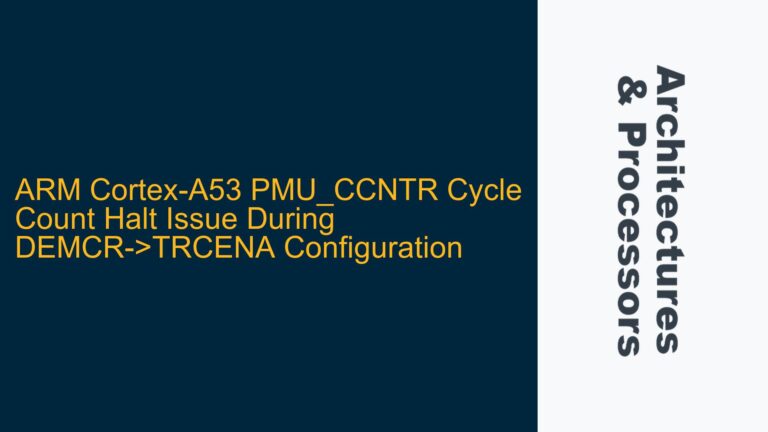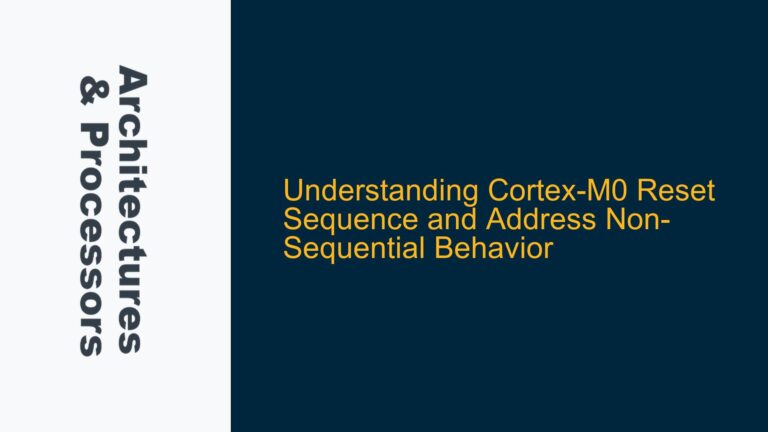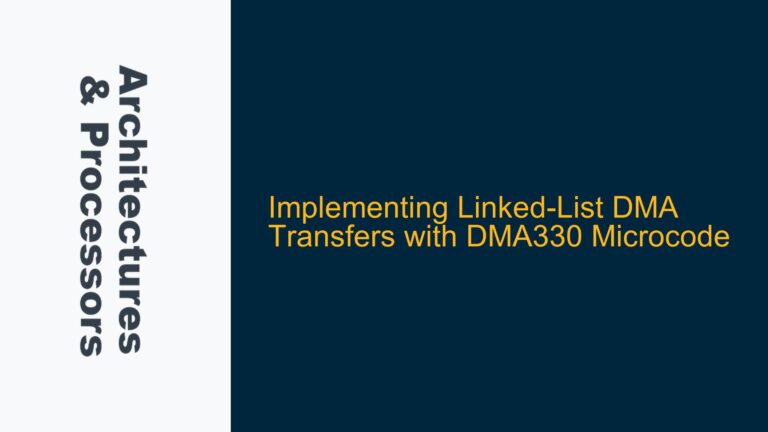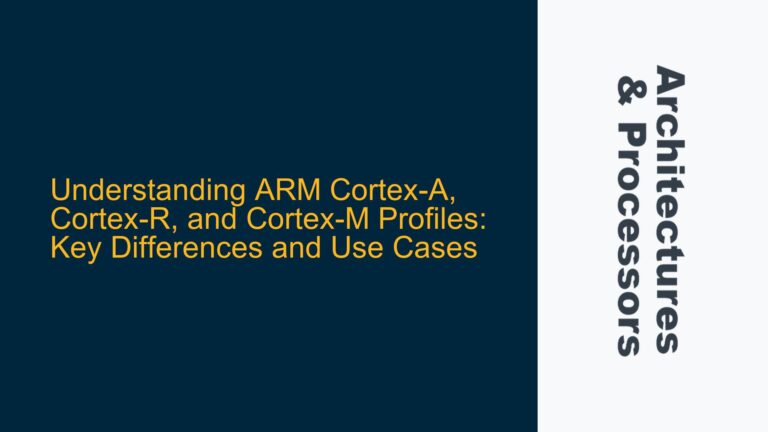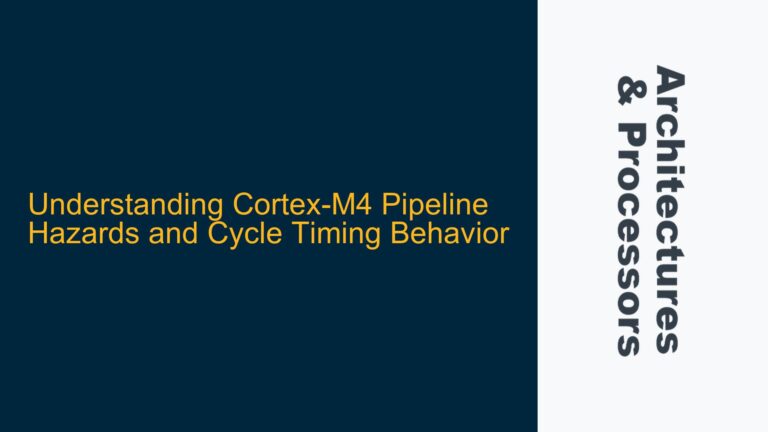ARM Cortex-M4 Cache Coherency Problems During DMA Transfers
The Neoverse N1 microarchitecture, a high-performance ARM core designed for server and infrastructure workloads, exhibits unexpected pipeline behavior when executing specific arithmetic instructions with large shift values. Specifically, the adds instruction with a logical shift left (LSL) greater than 4, such as adds x3, x4, x5, lsl #32, is documented to utilize the M (Multiply) pipeline. However, empirical testing on Graviton 2 (which implements the Neoverse N1) reveals that this instruction appears to execute on the I (Integer) pipeline instead. This discrepancy has significant implications for performance optimization, particularly in scenarios where pipeline saturation and instruction-level parallelism are critical.
The M pipeline is typically reserved for complex arithmetic operations, including multiplication and multiply-accumulate (MADD) instructions, while the I pipeline handles simpler integer operations. The Neoverse N1 Software Optimization Guide explicitly states that adds with LSL >4 should use the M pipeline, but experimental results contradict this. When the M pipeline is saturated with mul instructions, the addition of adds x3, x4, x5, lsl #32 does not increase the cycle count, suggesting parallel execution. Conversely, when the I pipeline is saturated with simple add instructions, the inclusion of adds x3, x4, x5, lsl #32 increases the cycle count, indicating contention for the I pipeline.
This behavior raises questions about the accuracy of the pipeline assignment documentation and the underlying microarchitectural implementation. Understanding the root cause of this discrepancy is essential for developers aiming to optimize code for the Neoverse N1, as misaligned pipeline assumptions can lead to suboptimal performance.
Memory Barrier Omission and Cache Invalidation Timing
The unexpected pipeline behavior of adds with LSL >4 in the Neoverse N1 can be attributed to several potential causes, ranging from documentation inaccuracies to microarchitectural optimizations. Below, we explore the most plausible explanations:
1. Documentation Inaccuracy: The Neoverse N1 Software Optimization Guide may contain an error regarding the pipeline assignment for adds with LSL >4. While the guide specifies the M pipeline for this instruction, the actual hardware implementation might route it through the I pipeline. This discrepancy could stem from an oversight during documentation updates or a last-minute microarchitectural change that was not reflected in the published materials.
2. Microarchitectural Optimization: The Neoverse N1 might employ a microarchitectural optimization that dynamically reassigns certain adds instructions to the I pipeline under specific conditions. For example, if the M pipeline is heavily utilized, the processor could offload adds with LSL >4 to the I pipeline to balance workload and improve throughput. This behavior would align with the observed experimental results, where adds with LSL >4 does not contend with mul instructions for the M pipeline but does contend with simple add instructions for the I pipeline.
3. Instruction Decoder Behavior: The instruction decoder in the Neoverse N1 might classify adds with LSL >4 as a simple arithmetic operation rather than a complex one, leading to its assignment to the I pipeline. This classification could be based on internal heuristics or historical performance data indicating that such instructions are more efficiently processed by the I pipeline.
4. Pipeline Resource Sharing: The Neoverse N1 might share certain resources between the M and I pipelines, allowing instructions to be flexibly routed based on availability. In this scenario, adds with LSL >4 could be processed by either pipeline depending on resource contention, leading to the observed behavior.
Implementing Data Synchronization Barriers and Cache Management
To address the pipeline behavior discrepancy and optimize code for the Neoverse N1, developers can follow a systematic approach to troubleshooting and performance tuning. Below, we outline detailed steps to diagnose the issue, validate pipeline assignments, and implement effective solutions.
1. Validate Pipeline Assignments: Begin by conducting controlled experiments to validate the pipeline assignments for adds with LSL >4. Use performance counters to monitor pipeline utilization and identify which pipeline (M or I) is actually processing the instruction. Compare the results with the documentation to confirm the discrepancy.
2. Analyze Instruction Throughput: Measure the throughput of adds with LSL >4 under varying pipeline saturation conditions. For example, saturate the M pipeline with mul instructions and observe the impact of adding adds with LSL >4. Repeat the experiment while saturating the I pipeline with simple add instructions. This analysis will provide insights into the instruction’s true pipeline affinity.
3. Review Microarchitectural Documentation: Consult additional microarchitectural resources, such as technical reference manuals or white papers, to gather more information about pipeline assignments and potential optimizations. Look for any mentions of dynamic pipeline routing or resource sharing that could explain the observed behavior.
4. Experiment with Instruction Scheduling: Adjust the scheduling of adds with LSL >4 within your code to minimize pipeline contention. For example, if the instruction is indeed using the I pipeline, avoid placing it in close proximity to other I-pipeline-bound instructions. Instead, interleave it with M-pipeline-bound instructions to maximize parallelism.
5. Leverage Compiler Optimizations: Modern compilers often include optimizations for specific microarchitectures. Ensure that your compiler is configured to target the Neoverse N1 and explore compiler flags or pragmas that influence instruction scheduling and pipeline utilization.
6. Implement Custom Assembly Routines: For performance-critical sections of code, consider writing custom assembly routines that explicitly manage pipeline assignments. Use inline assembly or standalone assembly files to control the placement and scheduling of adds with LSL >4 and other instructions.
7. Monitor and Adjust: Continuously monitor the performance of your code using profiling tools and performance counters. Adjust instruction scheduling and pipeline assignments based on empirical data to achieve optimal throughput.
8. Engage with ARM Support: If the discrepancy persists and significantly impacts performance, engage with ARM support to seek clarification and guidance. Provide detailed experimental results and code samples to facilitate their analysis.
By following these steps, developers can effectively diagnose and address the pipeline behavior discrepancy in the Neoverse N1, ensuring optimal performance for their applications. Understanding the nuances of pipeline assignments and microarchitectural optimizations is crucial for unlocking the full potential of ARM processors in high-performance computing environments.

